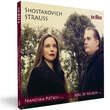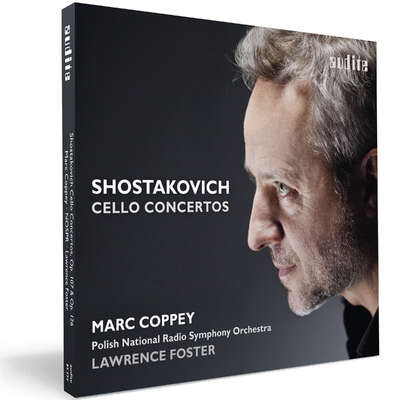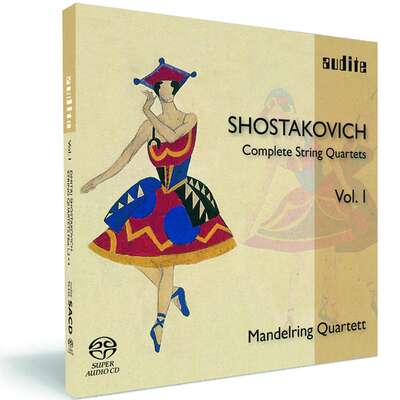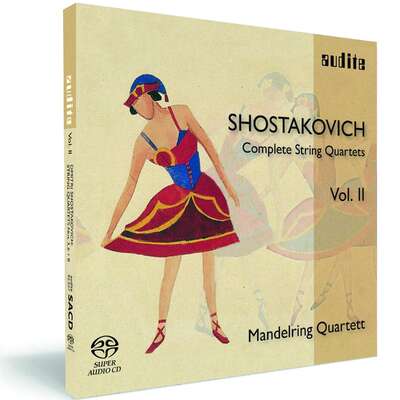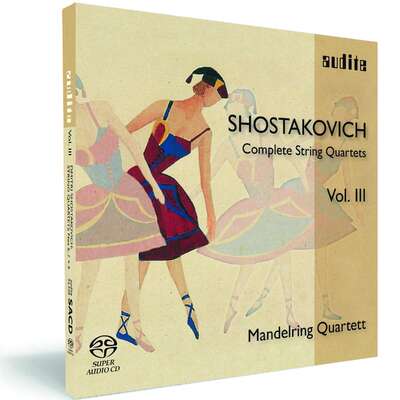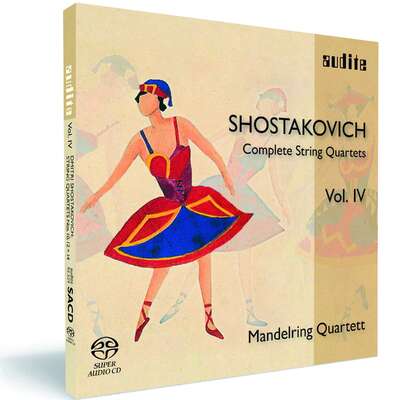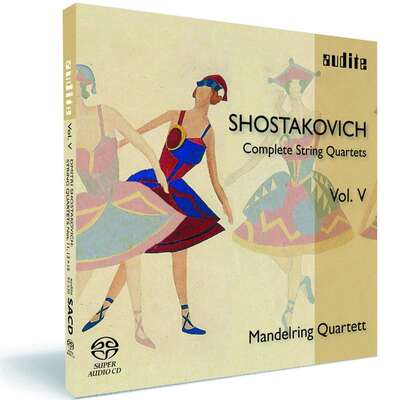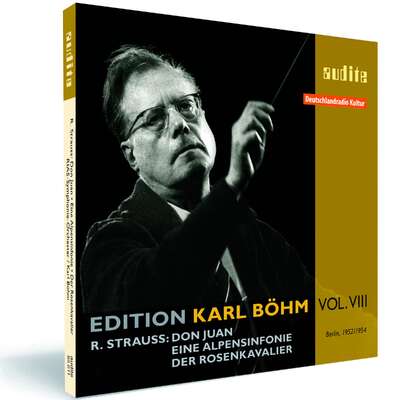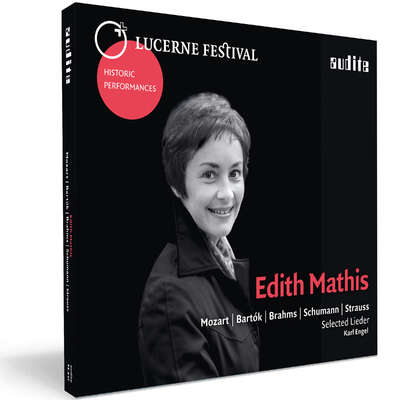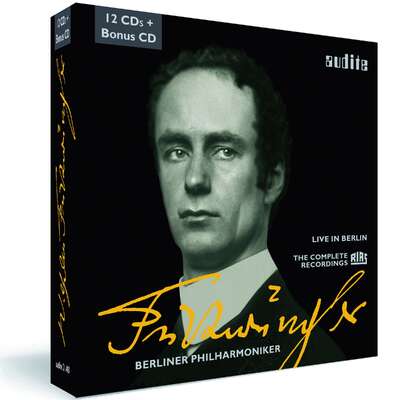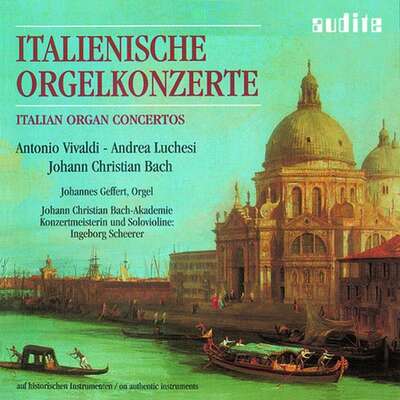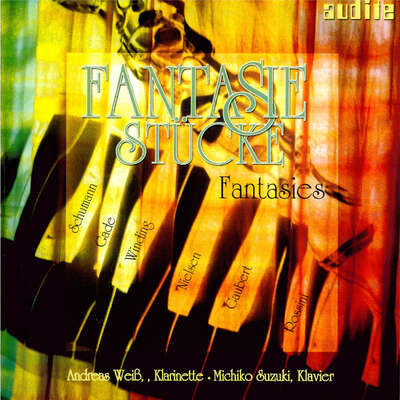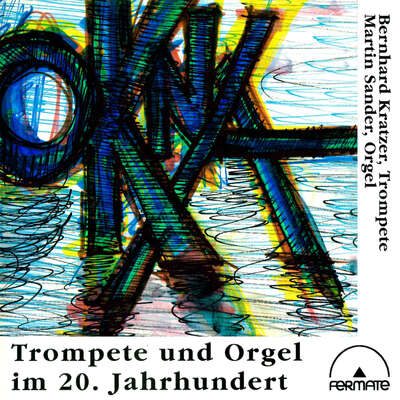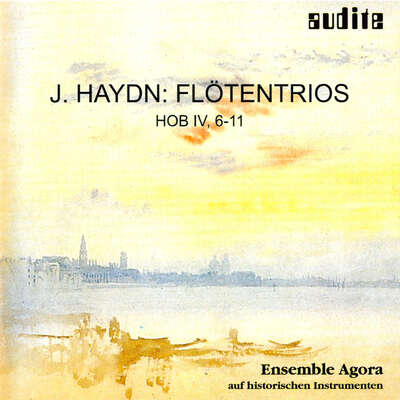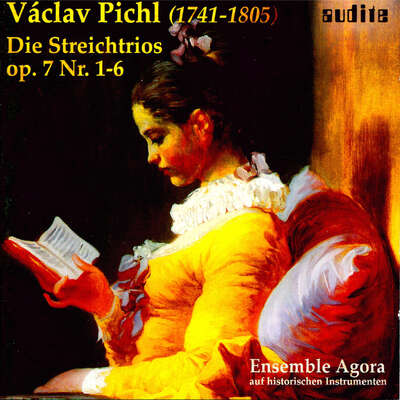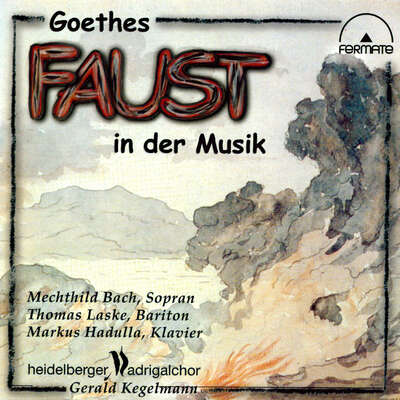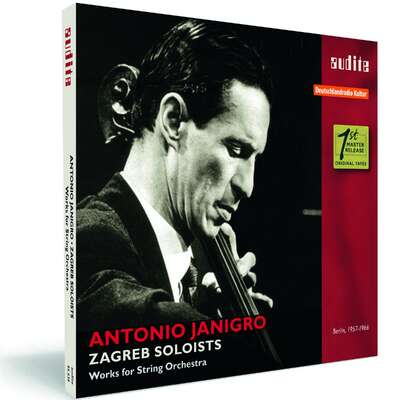
Richard Strauss’s jubilant and romantic Violin Sonata (1888) was written amidst the relative innocence of fin-de-siècle Europe; Dmitri Shostakovich wrote his mournful and bleak Sonata (1968) at the height of the Cold War, in the twilight of his existence. Franziska Pietsch and Josu De Solaun bring new life to two starkly contrasting works that together present a complex and emotional portrait of human existence.more
"Besides her great musicality, Pietsch is also a colorist, matching different tonal qualities to suit each passage. She unleashes an angry, acerbic outburst in the Scherzo, surpassing anyone I’ve heard before." (Fanfare)
Details
| Richard Strauss & Dmitri Shostakovich: Sonatas for Violin & Piano | |
| article number: | 97.759 |
|---|---|
| EAN barcode: | 4022143977595 |
| price group: | BCA |
| release date: | 8. March 2019 |
| total time: | 63 min. |
Bonus Material
Informationen
Two soloists in conversation:
The electrifying duo debut recording of violinist Franziska Pietsch and pianist Josu De Solaun features two masterpieces: the violin sonatas by Richard Strauss and Dmitri Shostakovich.
Since 2017, Pietsch and De Solaun have forged a remarkable partnership, each balancing and complimenting the other's musical temperaments and sensibilities.
Franziska Pietsch, who caused a sensation among other things with her solo recital recording last year, led several prestigious orchestras in Germany and Luxembourg as concertmaster before she continued her career as a soloist and chamber musician. The Spanish pianist Josu De Solaun, winner of the renowned competitions Enescu and Iturbi, has performed with orchestras and in recitals throughout the world. Next to his solo career he is a passionate chamber musician.
Together, these two artists breathe new life into two powerful compositions, presenting a complex, passionate, and emotional portrait of human existence.
The present recording is the start of several upcoming duo recording projects. In addition, Josu De Solaun will present his first solo recording on audite with works by Janáček, Novák, and Suk. More solo recordings are being planned.
Reviews
Der Tagesspiegel | 17.01.2021 | Georg Rudiger | January 17, 2021 | source: https://www.tage...
Kraft gibt nur die Musik
Wunderkind, Konzertmeisterin, Solistin
Der zweite Satz der Sonate op. 134 ist eine einzige Panikattacke. Franziska Pietsch spielt die atemlosen Sechzehntel auf ihrem Album von 2019, als hätte sie die Kontrolle über ihren Bogen verloren: wild, hysterisch, aufgescheucht. Auch die 51-jährige Geigerin wurde jahrelang von dem Alptraum geplagt, dass jemand an die Tür klopft und sie abholt.Mehr lesen
Fanfare | February 21, 2020 | Ken Meltzer | February 21, 2020 | source: https://www.amaz... A bold and brilliant pairing of violin sonatas by Strauss and Shostakovich
A new Audite release offers a thought-provoking coupling of violin sonatas by Richard Strauss and Dimitri Shostakovich, written respectively in theMehr lesen
By contrast (and it’s difficult to imagine a more profound one), Shostakovich wrote his Violin Sonata, op. 134, dedicated to David Oistrakh, in 1968. Shostakovich was 62, and just four years away from his death, due to lung cancer. In addition to the hardships of surviving the Stalin era and the Nazis, Shostakovich had suffered a heart attack, as well as contracting a form of polio that ended his ability to play the piano, and even made putting notes to paper a difficult task. Is it any wonder that the Symphony No. 14, composed in 1969, is a setting of various poems about death, or that at the work’s premiere, Shostakovich told the audience: “Death is in store for all of us and I for one do not see any good in the end of our lives. Death is terrifying. There is nothing beyond it.” In the Shostakovich op. 134 Violin Sonata, an expansive opening movement, bleak in mood and spare in texture, yields to a brief scherzo, a danse macabre laden with violence and anger. The finale is a passacaglia in slow tempo, based upon a 12-tone theme. The movement is constructed as a grand arch, building to a fearsome climax before resolving to hushed resignation. A final cry of pain yields to the whispered closing measures.
Both sonatas receive superb performances from the duo of violinist Franziska Pietsch and pianist Josu de Solaun. The Strauss is played with arresting virtuosity, rich and vibrant tone, and imaginative and superbly executed flexibility of phrasing. This is a performance with a level of precision that can only be the product of meticulous preparation, but one that still sounds absolutely spontaneous. The musicians adopt a far more austere voice for the Shostakovich, but with no lack of the requisite power for the work’s emotionally crushing moments. Once again, the level of execution is on the highest plane. In short, Pietsch and Solaun both highlight the stark contrasts between the two sonatas, and realize each work’s individual greatness. These excellent performances are reproduced in marvelous, lifelike sound; impactful, but without any sense of artificial enhancement. Jose de Solaun’s superb program notes—passionate, insightful, elegantly written, informative, and educational, but without a hint of pedantry—are a model of their kind, and a true asset to the project. This is not a recording designed for easy commercial success, but it deserves to be heard by the widest listenership possible. Highly recommended.
American Record Guide | September / October 2019 | Joseph Magil | September 1, 2019
Born and trained in Trieste, Franco Gulli (1926-2001) was one of Italy’s leading violinists in the 20th Century. In 1972 he became a professor atMehr lesen
Gulli is accompanied here by his wife Enrica Cavalli in excerpts from recitals they gave in Milan in 1981 and 1990. The Violin Sonata of Richard Strauss and the FAE Sonata were recorded in 1990, and Bartok’s Violin Sonata 2 was recorded in 1981. From what I can hear, the Gullis were outstanding musicians, and their interpretations leave nothing to be desired. I wish I had had the opportunity to hear him in concert. A friend of mine who did found him remarkable.
I regret to report that the recorded sound from both recitals is not acceptable. They sound like they were both recorded from the audience on amateur equipment. Once or twice, I can hear a man coughing whose mouth sounds like it is mere inches from the microphone. Gulli is not well represented in recordings, and these are the best performance of his that I have heard.
I was greatly impressed by Franziska Pietsch’s Prokofieff violin sonatas (N/D 2016), so I was excited when this came for review. I am happy to report that my expectations were exceeded. Pietsch plays this music like she is improvising. A native of East Berlin, she didn’t learn this score, she lived it. Until now, my top recommendation for this work was the wonderful recording by the Khachatryan siblings, Sergey and Lusine (J/A 2008). They characterize moments with remarkable vividness. Pietsch and Josu de Solaun play in a different manner. They are not as quicksilver in coloring their sound, but Pietsch especially brings a feeling of great familiarity with the music and its motivation that has the stamp of authority. She has her own way of tone painting that many violinists would never think of. At 5:42 of the first movement, she very briefly lowers the pitch of the note she is playing, producing an effect I had never heard before that I would describe as sickly yet absolutely appropriate. I am sure this is not a technical lapse but a wise choice. She eschews brilliance and polish and plays straight from the heart, and the effect is cathartic. This is at least on a par with the Khachatryans. The recording is warmer and much more present too, so the pianissimo passages aren’t as quiet as they are on the Armenians’ disc; but the enveloping sound, especially in the piano, enhances the music’s emotional effect. This recording is an essential acquisition for people who value this work, the second great Soviet violin sonata after Prokofieff’s Sonata 1.
The Strauss Sonata almost feels like a makeweight, and it was wisely placed before the Shostakovich. I say almost, because Pietsch once again shows what a superb artist she is. She is especially effective in the passages at lower dynamics, as she so often is. She and Solaun don’t quite storm the heavens the way Frank Almond and Wolfgang Wolfram do (M/J 2007), but this is one of the best readings of the work that I’ve heard, and Strauss’s bold optimism comes through powerfully.
Gulli played two Stradivarius violins, the “Marechal Berthier, Vecsey” of 1716 and the “Conte Fontana” dated 1702 on its label but probably from around 1690. Pietsch plays a violin made by Carlo Antonio Testore of Milan in 1751.
www.amazon.com | August 26, 2019 | Huntley Dent | August 26, 2019 | source: https://www.amaz... Pietsch continues to make compelling recordings one after the other
I’m at a loss whether to call this unusual juxtaposition of Strauss and Shostakovich balanced or schizoid—all the melodic rapture belongs toMehr lesen
Since I’ve never collected the work, I have no decided opinions about existing recordings, but to my ears the superb German violinist Franziska Pietsch and competition-winning Spanish pianist Josu De Solaun offer an ideal performance. I’ve admired every release I’ve heard from Pietsch, who has grown into a major interpretative talent from her beginnings as a child prodigy in East Germany. Her playing exhibits real command besides the expected tonal beauty, perfect technique, and musicality. Strauss wrote a solo-quality part for the piano, too, and De Solaun takes full advantage in bold, bravura style. Pietsch’s equally bold, expansive approach gives the piece a dramatic dimension missed by even such stellar violinists as Gil Shaham and Gidon Kremer, both on DG.
If the Strauss came at the beginning of his golden triumphant years, the Shostakovich Violin Sonata belongs to a late period where acclaim and the end of any possible political persecution were counterweighed with bad health and flagging energy. In collaboration with David Oistrakh, the dedicatee, the sonata was completed in October 1968, and in keeping with the gray no man’s land of the early Brezhnev years, it can be played for stark desolation, tight-lipped understatement, and bitterness. Even without editorializing, it’s a work that gains its power, as with so much late Shostakovich, by staring life’s grim realities in the face.
I sometimes wonder how violinists could discover any bright spots in the score; moreover, the famous and all-but-definitive Melodiya recording with Oistrakh and Richter seemed to extract the utmost in emotion, such as it was, that the score could offer. The piece’s enervated expression calls for the passacaglia theme in the finale to be introduced in dry pizzicato by the violin, as if muttered on the verge of a refusal to speak. Pietsch and De Soluan are less existential than Oistrakh and Richter (we aren’t invited to bring suicide pills with us, just in case). Pietsch uses a purer, less abrasive tone than Oistrakh, and long stretches are more meditative than despairing.
One advantage of a softened approach is that when Pietch’s violin does cry out desperately, the gesture makes for a strong contrast, where Oistrakh and Richter can seem relentlessly dogged. Besides her great musicality, Pietsch is also a colorist, matching different tonal qualities to suit each passage. She unleashes an angry, acerbic outburst in the Scherzo, surpassing anyone I’ve heard before. She bows with a wildness almost shocking as the music’s fury mounts. In the finale Pietsch and De Solaun inject interest, even mystery, into writing that can feel deliberately banal.
Altogether, despite the odd programming, this is an outstanding release and a must-listen for both works if you love them. The recorded sound is close, detailed, and very lifelike. The two performers have been a duo only since 2017—this is their debut disc together—and it is announced that they will make a series of recordings for Audite. I am eager to hear what they have to say, with every expectation that it will be exceptional.
F. F. dabei | 16/2019 | August 3, 2019 SHOSTAKOVICH, STRAUSS
Die Violonistin Franziska Pietsch und der Pianist De Solaun widmen ihreMehr lesen
Fanfare | August 2019 | Huntley Dent | August 1, 2019
I’m at a loss whether to call this unusual juxtaposition of Strauss and Shostakovich balanced or schizoid—all the melodic rapture belongs toMehr lesen
Since I’ve never collected the work, I have no decided opinions about existing recordings, but to my ears the superb German violinist Franziska Pietsch and competition-winning Spanish pianist Josu De Solaun offer an ideal performance. I’ve admired every release I’ve heard from Pietsch, who has grown into a major interpretative talent from her beginnings as a child prodigy in East Germany. Her playing exhibits real command besides the expected tonal beauty, perfect technique, and musicality. Strauss wrote a solo-quality part for the piano, too, and De Solaun takes full advantage in bold, bravura style. Pietsch’s equally bold, expansive approach gives the piece a dramatic dimension missed by even such stellar violinists as Gil Shaham and Gidon Kremer, both on DG.
If the Strauss came at the beginning of his golden triumphant years, the Shostakovich Violin Sonata belongs to a late period where acclaim and the end of any possible political persecution were counterweighed with bad health and flagging energy. In collaboration with David Oistrakh, the dedicatee, the sonata was completed in October 1968, and in keeping with the gray no man’s land of the early Brezhnev years, it can be played for stark desolation, tight-lipped understatement, and bitterness. Even without editorializing, it’s a work that gains its power, as with so much late Shostakovich, by staring life’s grim realities in the face.
I sometimes wonder how violinists could discover any bright spots in the score; moreover, the famous and all-but-definitive Melodiya recording with Oistrakh and Richter seemed to extract the utmost in emotion, such as it was, that the score could offer. The piece’s enervated expression calls for the passacaglia theme in the finale to be introduced in dry pizzicato by the violin, as if muttered on the verge of a refusal to speak. Pietsch and De Soluan are less existential than Oistrakh and Richter (we aren’t invited to bring suicide pills with us, just in case). Pietsch uses a purer, less abrasive tone than Oistrakh, and long stretches are more meditative than despairing.
One advantage of a softened approach is that when Pietch’s violin does cry out desperately, the gesture makes for a strong contrast, where Oistrakh and Richter can seem relentlessly dogged. Besides her great musicality, Pietsch is also a colorist, matching different tonal qualities to suit each passage. She unleashes an angry, acerbic outburst in the Scherzo, surpassing anyone I’ve heard before. She bows with a wildness almost shocking as the music’s fury mounts. In the finale Pietsch and De Solaun inject interest, even mystery, into writing that can feel deliberately banal.
Altogether, despite the odd programming, this is an outstanding release and a must-listen for both works if you love them. The recorded sound is close, detailed, and very lifelike. The two performers have been a duo only since 2017—this is their debut disc together—and it is announced that they will make a series of recordings for Audite.
Gramophone | July 2019 | David Gutman | July 1, 2019
Prokofiev concerto couplings are two a penny these days yet Franziska Pietsch caused something of a stir with her recent contender (2/18), followingMehr lesen
Here she is back on familiar turf, having made her recent career as a chamber music specialist with such ensembles as the Trio Testore and Trio Lirico. Her new recital colleague, Josu de Solaun, has already undertaken a survey of the complete Enescu piano music for Naxos. A Spanish-born American resident and a multiple prize-winner in his own right, his playing has strength without steeliness and a distinctive warmth and finesse which may or may not be associated with his Shigeru Kawai instrument. Very much an equal partner, he also contributes the booklet notes. Pietsch seems an edgier kind of artist, with the frank emotionalism and potential resort to wide vibrato you might associate with Russian players.
Immaculately pitched in every sense, their Strauss is worth sampling even for those normally resistant to this kind of Romantic fare. Marginally less sympathetic than the sweet and subtle reading from Kyung Wha Chung and Krystian Zimerman, their music-making lacks nothing in intensity or fine detailing and is captured in very lifelike sound in the famous acoustic of the Jesus-Christus-Kirche of Berlin-Dahlem. Some may detect a lack of intimacy, sonic or otherwise; I'd say the score can take it.
In the more ubiquitous Shostakovich the pair are, at least initially, less stoical than David Oistrakh or Oleg Kagan, both with Sviatoslav Richter, injecting light as well as shade without sounding remotely facile. The extremely virtuoso second movement finds Pietsch positively assaulting her strings. The finale is again heartfelt but never too far over the top.
All in all an intriguing offering, even if the startlingly disparate programme won't file easily on the shelves of those of us still in thrall to physical format.
Süddeutsche Zeitung | Magazin Heft 26/2019 27. Juni 2019 | Carolin Pirich | June 27, 2019
GEGEN DEN STRICH
Als sie jung war, blockierte die DDR ihre Karriere. Jetzt stößt sie an die Grenzen der Musikbranche. Aber Grenzen sind ihre Spezialität: die erstaunliche Geschichte der Ausnahmegeigerin Franziska Pietsch
Sie fragt: Vielleicht möchten Sie mich in Aktion sehen? Man hätte dannMehr lesen
Fono Forum | Juni 2019 | Michael Kube | June 1, 2019
Mit ihrer alles andere als gradlinigen Karriere, bei der sie auf höchstem Niveau und mit wachsender Reputation alle musikalischen Konstellationen aufMehr lesen
Was etwa der junge Richard Strauss im kompositorischen Überschwang der Gattung und den Musikern abverlangt, dringt in den Bereich des Sinfonischen vor. Das Stück lotet nicht nur die Grenzen von Kammermusik aus, es verlangt darüber hinaus virtuose Fertigkeiten. Für Franziska Pietsch wirft dies hörbar keine Probleme auf, eher sucht sie das Risiko, und dies in einem strahlenden, mitunter vibrierenden Ton und einem Höchstmaß an Ausdruck.
Eigenartigerweise steht hier indes das Klavier unter den Händen von Josu de Solaun akustisch stärker im Vordergrund, als man es sich vielleicht wünscht, ebenso wie in den aufbrausenden Momenten der selten zu hörenden Sonate von Dmitri Schostakowitsch. So entsteht gelegentlich der Eindruck, als würden beide Musiker nicht nur eine sperrige Komposition deuten, sondern sich auch intensiv an ihr abarbeiten. Dass sich daraus am Ende eine einnehmend subjektive Perspektive entwickelt, die das fahle Element mit dem energischen Agitato ebenso versöhnt wie mit den wenige lichten Momenten, ist die fraglos größte Stärke dieser vor Energie nur so glühenden Einspielung.
Ritmo | June 2019 | Gonzalo Pérez Chamorro | June 1, 2019
[Josu de Solaun] ahora se acompaña con la violinista Franziska Pietsch, una intérprete habitual del sello Audite, para ofrecer dos Sonatas que coinciden en que sus autores vivieron cada momento de su vida pensando y sufriendo en la situación política que les tocó vivir. Mehr lesen
Scherzo | N° 352 - Junio 19 | Luis Suñén | June 1, 2019
Es difícil pensar en mejores versiones que las que aquí nos ofrecen Pietsch y De Solaun de estas dos obras magníficas cuya complementariedad aparentemente imposible es extraordinariamente interesante. Ambos asumen la pasión reinante, la fuerza tremenda que por momentos y por cuestiones expresivas diferentes propone cada obra, con una técnica impecable, llegando al límite de la propuesta de sus autores por la vía de la entrega y de la inteligencia.Mehr lesen
RBB Kulturradio | 09.05.2019 | Hans Ackermann | May 9, 2019 | source: https://www.rbb-...
Zwei höchst unterschiedliche Sonaten für Violine und Klavier spielen Franziska Pietsch und Josu de Solaun auf ihrer ersten gemeinsamen CD. BeiMehr lesen
23 Jahre jung war Richard Strauss, als er im Jahr 1888 in seiner Sonate op. 18 mit überschwänglichen Klängen jugendliche Freude zum Ausdruck gebracht hat. Schostakowitsch hingegen lässt in seiner späten Sonate von 1968 auch die Mühseligkeiten der letzten Lebensjahre anklingen – eine durch Krankheit und Resignation stark eingeschränkte Lebensfreunde.
Kontraste
Der Kontrast im jeweiligen Lebensgefühl der Komponisten könnte somit größer nicht sein – was die beiden Musiker zu einem beachtlichen gestalterischen Stimmungswechsel herausfordert: die freudigen Emotionen des Strauss’schen Frühwerks werden dabei ebenso intensiv vorgetragen, wie die stilisierte Kargheit in der Musik des russischen Komponisten.
Begegnung
Wie Schmetterlinge umschwirren sich in der Strauss-Sonate die beiden Instrumente, fliegen immer mal wieder auch auf getrennten Bahnen, kommen aber stets wieder zusammen – dynamischer kann diese intensive Kammermusik von Richard Strauss kaum interpretiert werden. Bei Schostakowitsch erzeugt die hervorragende Geigerin Franziska Pietsch mit ihrer Testore-Geige faszinierende Klänge, die der ebenbürtige Pianist Josu de Solaun mit großer Phantasie in seine Stimmverläufe aufnimmt.
Klangereignis
Die Musiker treiben die beiden hervorragend aufgenommenen Sonaten mit größter rhythmischer Präzision voran und schaffen so ein intensives Klangereignis – bei dem man beim Zuhören Gefahr läuft, das Atemholen zu vergessen.
www.prestoclassical.co.uk | 4th May 2019 | Katherine Cooper | May 4, 2019 | source: https://www.pres... Presto Editor's Choices - April 2019
[...] their approach is lithe, muscular and almost symphonic in places, but equally striking are the moments when the pair strip things back to a blanched sound-world which would scarcely be out of place in Debussy.Mehr lesen
https://artmusiclounge.wordpress.com | APRIL 20, 2019 | Lynn René Bayley | April 20, 2019 | source: https://artmusic... Pietsch & De Solaun play Strauss & Shostakovich
Pietsch is certainly an expressive player. I would put her performance of the Strauss sonata on a par with those of Ginette Neveu or Heifetz, the premiere representatives in their time of the French and Russian schools, respectively. Indeed, at times her playing put me in mind of the kind of intensity that Nadja Salerno-Sonnenberg has exhibited over lo these many decades of her storied career.Mehr lesen
www.pizzicato.lu | 19/04/2019 | Uwe Krusch & Guy Engels | April 19, 2019 | source: https://www.pizz... Franziska Pietsch: Gänsehautmomente beim Aufeinandertreffen von Lebensfreude und Trauer
Zu ihrer Aufnahme der Sonaten von Prokofiev, damals noch mit Detlev Eisinger am Piano, schrieb der Pizzicato-Rezensent, „Ihre Interpretation istMehr lesen
(Uwe Krusch) – Während die Sonate des 23-jährigen Richard Strauss durch jugendlichen Überschwang, frische Liebesgefühle und Zukunftsahnungen geprägt ist, schrieb Shostakovich, angegriffen und angeschlagen, in seine Violinsonate Angst und Trauer hinein. Soweit diese beiden Ansätze die Werke trennen, so eint sie doch die tiefen Gefühle, die sie vermitteln.
Franziska Pietsch stürzt sich mit Verve in die Interpretation und bringt es in beide Richtungen, Freude und Trauer, zu großer Darstellung. Da mag auch manches mit zu plakativen technischen Mitteln gespielt werden, wie einige gepresste Töne, Rutscher. Aber wer benimmt sich in überwältigender Freude nicht auch mal ein wenig schräg. Die Lebensgier und viel Kraft bei Strauss werden klar und deutlich.
Der erste Satz bei Shostakovich wirkt dann etwas zurückhaltend, aber die Emotionen kehren in den beiden Folgesätzen zurück.
Ihr neuer Begleiter, Josu de Solaun aus Spanien, hat es da trotz seines aufmerksamen und makellosen Spiels schwer, auf sich aufmerksam zu machen. Aber es gelingt ihm so, dass die Sonaten ein gemeinsames tiefschürfendes Klangbild beider Instrumente ergeben.
(Guy Engels) – Es ist vor allem die späte Shostakovitch-Sonate, die den Zuhörer in einen regelrechten Sog menschlicher Gefühle hineinzieht. Von der ersten Note an, von den ersten bedrohenden, bedrückenden Tönen fesselt diese Interpretation des Duos Pietsch-Solaun. Da stellen sich urplötzlich existenzielle Fragen in einer Art, wie nur perfekte Kenner von Shostakovichs Musik sie aufwerfen können.
Franziska Pietsch packt nicht nur ihr ganzes technisches Können aus – von bissigen, abgerissenen, kurzen Strichen zu tiefgründigem Lamento –, sie ist vor allem eine hervorragende Gestalterin, dies aus dieser über 30minütigen Sonate ein Drama von shakespearschem Charakter macht mit allen Abgründen, Freuden und Leidenschaften eines Menschenlebens.
Als Ouvertüre und perfekter Kontrast erklingt zunächst die spätromantische Strauss-Sonate, die Franziska Pietsch in einen schönen Ton mit sattem Schmelz kleidet, ohne dabei in naive Sentimentalität und Nostalgie vergangener Zeiten zu versinken.
Hier werden zwei große und grundverschiedene Werke des 20. Jahrhunderts hervorragend in all ihrer Gegensätzlichkeit von zwei ausgezeichneten Musikern interpretiert.
The violin sonatas by Strauss and Shostakovich are quite different. The first one, written by a young composer, is full of life and élan, the other is a late composition full of sorrow. Common to both works are their deep emotions which come to full expression in this recording by Franziska Pietsch and Josu de Solaun.
Musicalifeiten | 20.03.2019 | March 20, 2019 | source: https://musicali...
Pietsch en De Solaun tonen in een uitvoering vol vaart en verve maar ook met veel gevoel de waarde van dit werk aan en herinneren aan andere prachtvertolkingen van Vadim Repin en Boris Berezovsky en Kyung-Wha Chung met Krystian Zimerman.Mehr lesen
Classique HD | 11 mars 2019 | Nicolas | March 11, 2019 | source: https://classiqu...
Ensemble, les artistes font revivre les deux puissantes compositions et présentent un portrait complexe, passionné et émotionnel de l’existence humaine.Mehr lesen
